Filmic Interiors





Paradise! Luxury! Holiday destination! This was the hype of the new 1950’s Lennon’s Broadbeach Hotel. Hundreds of post-war families aspired to escape the dullness of their working homes to relax amongst the sunshine and picturesque beaches of the Gold Coast. However, the hotel did not last to fulfil this long-term dream.
The Lennon’s Broadbeach Hotel was designed by Karl Langer and developed by Lennons Hotels Ltd. It took from 1955 to 1957 to construct this building on the site of a former sand mine at Broadbeach, approximately eighty kilometres south from Brisbane (Rickard, K). This hotel was one of the many holiday accommodations developed as a result of the lifted planning restrictions after World War II (Queensland Heritage Register, 2012). For this reason, Karl Langer had a lot of creative freedom in designing this modernistic hotel.
As an influence of historical architecture movements such as modernism and post-modernism in the 1900’s, Langer embraced simplified lines, colour and style in the exterior of Lennon’s Broadbeach Hotel. His design expressed the “twentieth century subtropical” style that was most common amongst emerging Gold Coast resort-hotels (SLQ, 2012). A colour palette of reds, browns, blues and greens and an influx of tropical flora support this ideal.
However, the hotel did not last the extent of its optimism. The Lennon’s Broadbeach Hotel was bought and sold several times and went under numerous modifications in order to save the property. This happened for 30 years before the hotel was demolished in 1987 (Rickard, K). Journalists suggest that the hotel was a “white elephant” (McRobbie, 1984), meaning that it was troublesome to maintain considering the empty surroundings of the hotel.
It is important for contemporary designers to reflect on why hotels like these failed. Many factors would have contributed to the demolition of the Lennon’s Broadbeach Hotel, however, it would be most useful to begin at a more detailed perspective. One way to do this is take a sample of the interior space.

This photograph of the public bar shows multiple points of interest. The entry feature is composed of a timber framed glass wall with multiple stained colours. When one enters the private bar, they see two 6-metre hardwood-timber bench seats with brick dwarf wall supports to their left. To their right, they are greeted by a 9.8-metre curved polished marble countertop with a hardwood edge. The counter-front is feature brick supporting the counter.
The north wall is a feature stone wall set in concrete. All other walls are painted plaster. The main flooring outside of the bar is 300mm tiles and behind the bar is vinyl sheeting turned up at the skirtings. Both floors are laid on concrete slab. When looking above, the ceiling consists of plaster tiles and spot lighting. There is also a smoke exhaust unit for in-house smoking. The steel posts in the middle of the room support ceiling beams.
There are various freestanding units in the centre of the bar such as steel cabinets, glass racks and dishwashing machines. Aboriginal murals are painted on the western wall and steel posts – this reflects the indigenous heritage of Australia during that time. Multiple swivel stools complete the bar area.
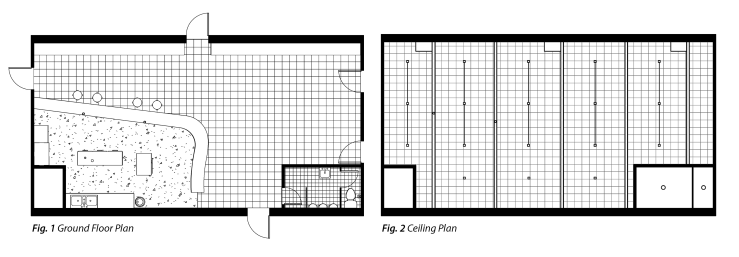

The Private Bar is situated at the western side of the building lot. It has doors connecting to the bottle department, beer garden, loading dock area, garden and lounge. The connection to the bottle department allows easy access to stock and the beer garden allows access to an outside atmosphere. It is assumed that the Private Bar was an exclusive area for gentlemen only. This is because there is a male-only bathroom and the bar is accessible from other high-end areas such as the lounge and garden.
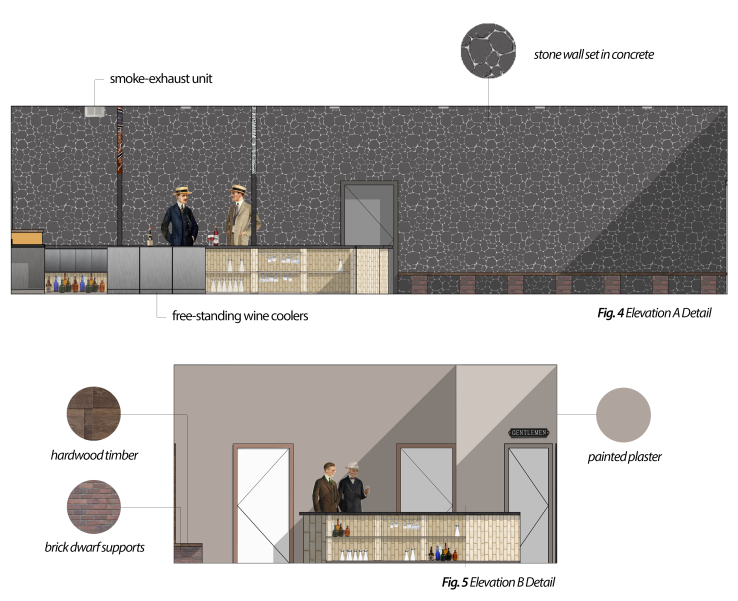
Elevation A and Elevation B shows us a depiction of the bar materials and why they were used. The stone wall was used as a feature frontal. It has always been a popular design choice to use stone as a feature element because it looks interesting and is very durable. Painted plaster was used for the other walls because it is a standard practice. For the seating, hardwood timber bench seats were used because timber was plentiful during the 1900’s and is a very solid material (If we observe typical church benches today, we can see how hardwood timber can last hundreds of years). There are also brick dwarf wall supports used for added durability. In miscellaneous elements, there are smoke exhaust units for in-house smoking as well as wine cooler units to store cold drinks.
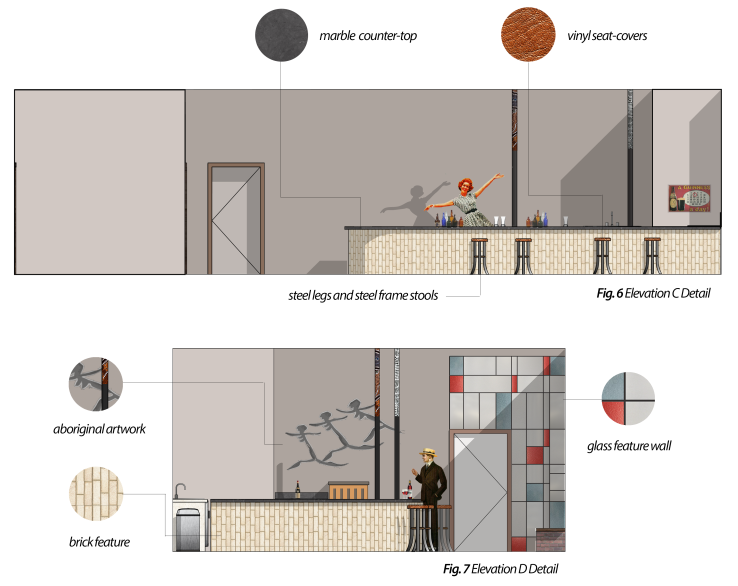
As observed in Elevation C and Elevation D, there are multiple decorative elements. The marble countertop is an aesthetic element that is very durable and easy to clean. Marble is very popular amongst bar areas even to this day. The steel bar stools, more specifically their legs and frame, are also used for durability and cleanliness. They are topped with vinyl seat-covers that are a depiction of the 1950’s bar style. Additional brick feature has been used as the counter-front material because it is easy to sustain.
The glass wall in Elevation D is a depiction of Karl Langer’s modernistic style – using simplified lines and primary colours to bring some light to the room. This appears to be the only other light source than the spot lighting. There are no windows in the room and so it appears that the bar is quite dark and enclosed. This supports the intentional privacy of the area.
Not shown in the elevations but shown in Figure 3 are 300mm grey tiles that can be easily washed down at the end of the day. These tiles are more efficient for bars than carpet because users will be dealing with alcohol and may spill drinks on the floor. Behind the bar is vinyl sheeting that is turned up at the skirting (coving) to give an aesthetic finish and be easily wiped with a mop. Karl Langer has taken convenience into his design choices.
As the Lennon’s Broadbeach Hotel was built on the Gold Coast, it is beneficial to look at contemporary bars that have been built around its place. A few of the most popular Gold Coast bars include Sting Ray Bar and Lounge, Fix Cocktail Bar and One50 Public House (figures 8, 9, 10). These are all contemporary modern bars established from 2011-2014.
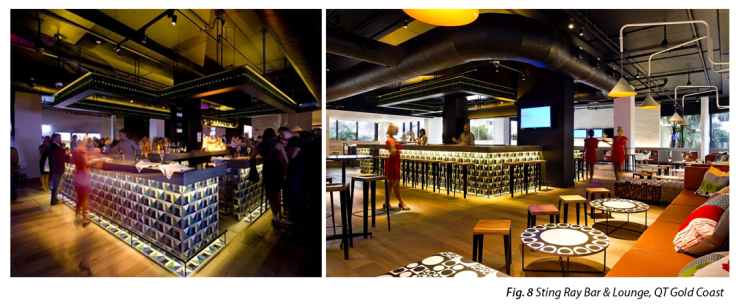
The recurring design choice amongst all these bars is the striking focal point. Contemporary design has a huge emphasis on this principle because, without a focal point, the users will not know how to guide themselves through the space. These focal points are accentuated through colour, height and rhythm. The Sting Ray Bar and Lounge (fig. 8) is an excellent example of this because it uses bright yellow colours and mosaic patterns to draw attention and flow to the space. The bar also uses a suspended bulkhead to point the focus of the bar into the centre.
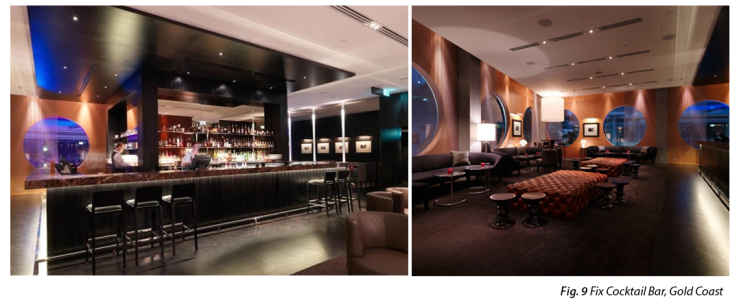
Another successful aspect of these bars is the mood. As shown in Fix Cocktail Bar (fig. 9), the designers have done an excellent job in creating a sense of luxury and comfort. This is due to the elegant dim lighting, warm earthy colours, and the spacious layout of the room. Luxurious padded leather chairs and non-obstructive furniture makes this area appear inviting and relaxed. Lighting is used purposefully to enhance the expensive finishes of the room – it adds glossiness to the bar, making it feel very high-end and valuable.
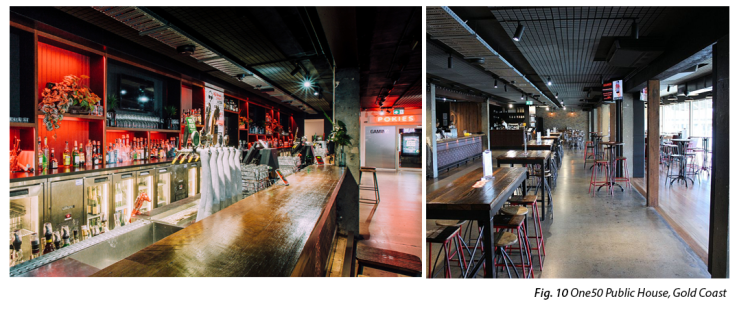
Lastly, materials and furniture are what finishes a contemporary bar off. This is the opportunity for designers to make sustainable and convenient choices in their space. One50 Public House (fig. 10) has used the opportunity to use recycled timber benches and columns in their area, as well as re-purposed steel and polished concrete for ease of cleaning. All the furniture is on castors or can be easily shifted, thus allowing the layout to be re-designed at minimal cost. This flexibility and sustainability is very common in contemporary design.

The original floor plan by Karl Langer (digitised in fig. 11) was not very detailed and therefore did not offer much information regarding the interior design of the space. It is important to note that the legislation supporting interior design as a profession was not passed until 1982 (IDLNY, 2016). This is decades after the Lennon’s Broadbeach Hotel was built. The problem with most 20th century buildings is that a lot of existing literature writes about the architecture of the building and little about the interior. Interior design is just as important because it offers unique insights to the building and allows us to perform closer readings of the space.
Morphology
There are a couple of differences between the original floor plan and the photographical evidence of the space. Firstly, the opening to the bottle department from behind the bar was removed. This is extremely inefficient because it means the bartender has to move out the southern back door to have access to the stock. It also requires two staff members to operate both areas at the same time, rather than one staff member moving between the two and serving both areas at a lesser cost.
There is also evidence of furniture and freestanding units in the adapted floor plan. By brief observation, these units do not seem to have an efficient set-up – they appear cluttered and randomly placed. When bars get busy, it is important that the staff can navigate the space safely and efficiently. In an aesthetic perspective, the exposed units mean that the bar patrons have to look at extra clutter and dirty dishes in the back sink.
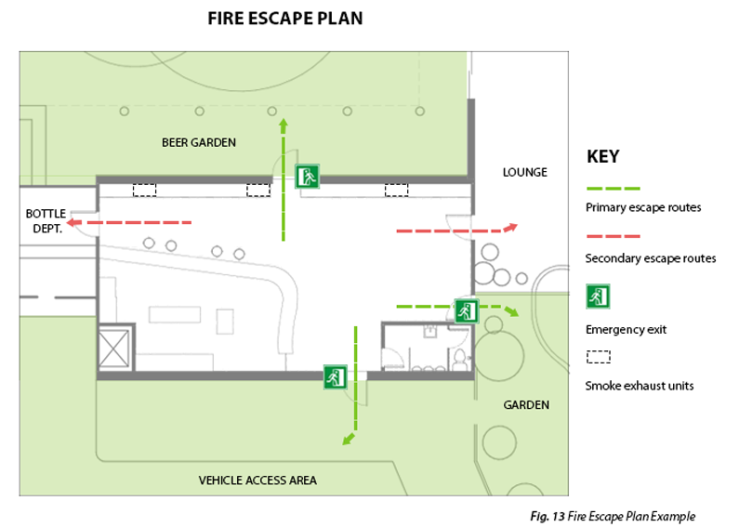
Fire egress
Fire egress is overall adequate but not perfect. There are three primary escape routes to open areas and two secondary escape routes to other rooms in the building. Based on the previous photographic evidence, there are small smoke exhaust units for smoking indoors. It is noted that these units would not be designed for fire smoke. However, most materials used in the area (brick, tiles, stonework) are fire resistant and would not fuel large fires. Softer materials such as vinyl do impose a safety concern because it can produce dangerous fumes when lit – therefore the lack of windows can be problematic if the doors are obstructed. In addition to this, the first national standard for smoke detectors emerged in 1967 and so it is unlikely they were implemented in this space (Mysmokealarm.org, 2013). When there are intoxicated patrons roaming the space, the lack of detectors may impose serious consequences due to the less appropriate reaction time.
Sustainability
Sustainable design seeks to reduce negative impacts on the environment (GSA.gov, 2016). It is most likely that Karl Langer did not focus on sustainable practices in his hotel because of the lack of building legislation and environment-friendly concerns during the 1950’s. When evaluating the private bar, there are multiple elements that lack sustainable practices. For instance, the embodied energy of most materials is quite high – brick and hardwood timber require a lot of processing energy to make. Additionally, the appliances used within the bar would have not been energy rated. Cleaning and dishwashing would have expedited a lot of energy and water consumption compared to contemporary appliances.
In order to make the private bar more sustainable, it would be wise to use recycled materials and reduce water usage wherever possible. On a positive note, materials such as concrete and stone in the space are quite environmentally friendly because they are extremely durable and do not require constant maintenance. It would also be wise to include natural or LED lighting in the space so there is less energy wastage.

Aesthetics
The main concern with a lot of typical 1950’s interiors is that there are so many feature elements. For instance, the private bar has a feature brick counter-frontal, a feature stone wall and a feature glass wall. All these features hinder the natural flow of the space because users do not know where to focus their eyes on. If the interior of the bar were re-made, I would definitely tone down the amount of feature elements and variety of materials in the space. The designer of the bar did not account for rhythm and simplicity because they seemed to have put whatever statement materials they could use together. There is also an effort to match the aboriginal art pieces together, however, they clash with the modern appearance of the feature glass wall. The aesthetic design of the bar would be much more aesthetically pleasing with these elements addressed.

Modernity
The Lennon’s Broadbeach Hotel private bar would not be socially acceptable in the 21st Century. One of the main reasons for this is that male-dominated private bars are a thing of the past. In 2016, an age of social acceptance and gender equality, a male bar would not be well accepted by the public. It is important to include male and female bathrooms that are both equally accessible in the space. It is also essential that there are options for disabled, elderly or pregnant guests, whether in the space or relocated closely elsewhere.
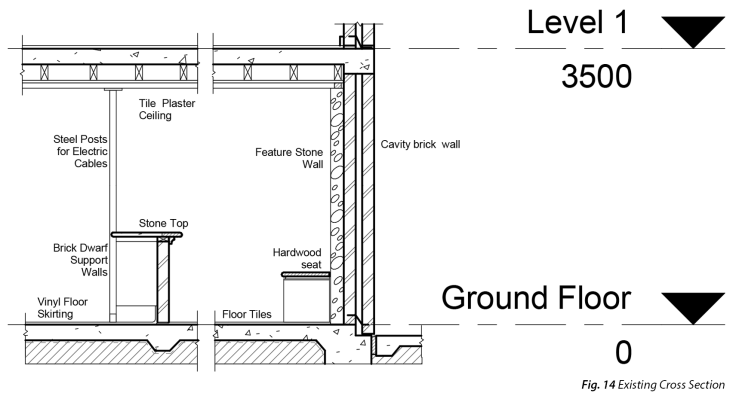
Working with Heritage
The concept of heritage buildings came about in 1979 by Burra Charter (Australia ICOMOS, 2013). It is questionable as to whether the Lennon’s Broadbeach Hotel should be considered a heritage building and whether it should be restored for this reason.
When thinking sustainably, it would be a huge waste to demolish the entirety of the building considering it has only lasted for 30 years. Since the private bar is half composed of brick and stone, it is fairly adequate to retain the internal walls and joinery (see fig. 14). However, the cost rates for renovation, additions and restoration are much more expensive than demolishing the building and starting over. Because there are a lot of accessibility and placement issues, it would be unwise to restore the private bar with the limitations of the original floor plan. Additionally, the lack of visitors and constant re-selling of the hotel (during those 30 years) would make funding difficult. When there is no funding to keep up the maintenance of buildings such as these, it is inevitable that the Lennon’s Broadbeach Hotel would quickly degrade. A perfect example of this is Pruitt-Igoe – a modernist city of apartments designed by Minoru Yamasaki and George Hellmuth in 1951. The buildings were advertised as a paradise of “bright new buildings with spacious grounds” alike Lennon’s Broadbeach Hotel, but became a location of slums and violent crime due to the lack of maintenance (Frishberg, 2013).
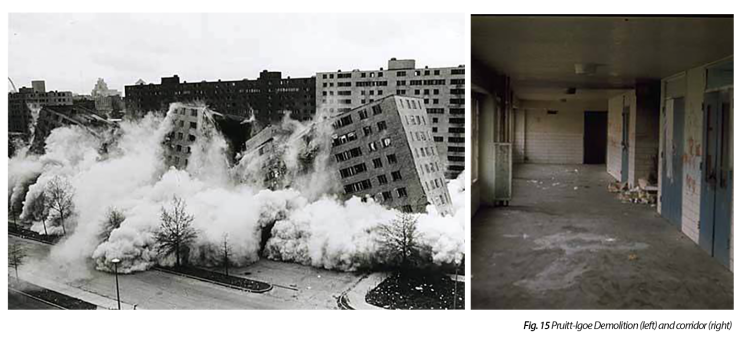
For these reasons, it is unwise to heritage-list the Lennon’s Broadbeach Hotel. I firmly believe that the upcoming generations of the Gold Coast would have no appreciation for heritage buildings. When the goal of bigger, taller and more luxurious hotels are in the mindset of the Gold Coast public, the Lennon’s Broadbeach Hotel would not be well received.
In conclusion, the Lennon’s Broadbeach Hotel is nevertheless one of the most iconic buildings on the Gold Coast. Karl Langer took the opportunity to explore new sub-tropical accommodation typologies that forever changed Gold Coast architecture. Although the hotel and its private bar would not last against contemporary hotels we have today, it nonetheless offered unique insights to the building and allowed us to make more appropriate decisions about our interior spaces. Would the Lennon’s Broadbeach Hotel be standing longer if more attention was made to its interior design? Most certainly. The private bar has taught us that the interior of the space is just as important as architecture when determining the successfulness of a building.
“A Brief History Of Interior Design”. 2016. Idlny.Org. http://www.idlny.org/history-of-interior-design.html.
“A Brief History Of Smoke Alarms”. 2013. My Smoke Alarm. http://www.mysmokealarm.org/brief-history-smoke-alarms/.
“Charters | Australia ICOMOS”. 2016. Australia.Icomos.Org. http://australia.icomos.org/publications/charters/.
“Fix Cocktail Bar”. 2016. Truelocal. http://www.truelocal.com.au/business/fix-cocktail-bar/surfers-paradise.
Frishberg, Hannah. 2013. “The Failed Paradise: Pruitt-Igoe”. Atlasobscura.Com. http://www.atlasobscura.com/articles/pruitt-igoe.
“Gold Coast Bars | Stingray Bar & Lounge | QT Gold Coast”. 2016. QT Gold Coast. https://www.qthotelsandresorts.com/gold-coast/eat-drink/stingray/.
“Hot Modernism”. 2012. State Library Of Queensland. http://www.slq.qld.gov.au/hot-modernism.
“Kinkabool (CHIMS 601477)”. 2009. Queensland Heritage Register (Brisbane: Queensland Government Department Of Environment And Heritage Protection, 2009). https://www.derm.qld.gov.au/chimsi/placeDetail.html?siteId=16240.
McRobbie, Alexander. 1984. The Fabulous Gold Coast. Surfers Paradise, Qld.: Pan News.
“ONE50 Public House – Features”. 2016. Atprofessional. http://www.atprofessional.com.au/news/one50publichouse.php.
Rickard, Katherine. 2016. “Run To Paradise: The Chevron Hotel, Gold Coast, From Foundation To Renaissance”. In Proceedings Of The Society Of Architectural Historians, Australia And New Zealand: 30, 1st ed., 57-66. Gold Coast, Qld: SAHANZ.
“Sustainable Design”. 2016. Gsa.Gov. http://www.gsa.gov/portal/content/104462.